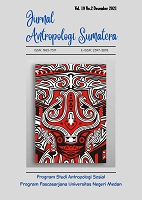Making Traditional Ingredients of Green Coconut Oil as a Facility for Medical and Non-Medical Treatment in Tembung, Percut Sei Tuan District
DOI:
https://doi.org/10.24114/jas.v21i1.49040Keywords:
traditional medicine, Young Coconut Oil, CultureAbstract
This study aims to analyze the prevalence of individuals choosing traditional medicine for both medical and non-medical treatment, emphasizing the unwavering faith of the Tembung community in the efficacy of traditional medicine, particularly green coconut oil, and herbal remedies. The literature review is anchored in the concept of preserving local wisdom in traditional medicine. Employing a qualitative research approach with an ethnographic lens, the author conducted data collection through observation, in-depth interviews, and documentation, utilizing Spradley's model for analysis. The findings reveal the persistent utilization of ancestral herbal remedies in traditional medicine, driven by ingrained beliefs and financial considerations, particularly as a cost-effective alternative for both medical and non-medical ailments. In summary, the study concludes that the community's strong belief in traditional medicine is rooted in its affordability and accessibility, allowing individuals to seek treatment without bureaucratic hurdles. The paper underscores the importance of government support and monitoring to ensure that traditional medicine aligns with regulations, fostering a sense of security for those seeking treatment within these practices. It is recommended that the government continues to collaborate with traditional medicine practices, ensuring a balance between cultural preservation and adherence to established standards.References
Arif, R. & Base, N. H. 2021. Inventarisasi Tanaman Dan Ramuan Tradisional Etnis Sulawesi Selatan Sebagai Imunomodulator. Jurnal Kesehatan Yamasi Makassar, 5(1) 42 “ 49
Pramushinta, I. A. K., & Sari, D. P. (2021). Pembuatan Ramuan Tradisional Untuk Mengatasi Diare Pada Anak. Jurnal Abadimas Adi Buana, 5(01), 1-4.
Ma™ruf, M., Roikhana, A., Maghfirah, L., Setiawati, S., Chumairoh, Z., Mufida, N., & Hasanah, D. (2021). Pengolahan Jamu Tradisional Sebagai Minuman Peningkat Imunitas Tubuh. Jurnal Pembelajaran Pemberdayaan Masyarakat (Jp2m), 2(2), 167-174.
Njatrijani, R. (2018). Kearifan Lokal Dalam Perspektif Budaya Kota Semarang. Gema Keadilan, 5(1), 16-31.
Siswadi, T. T., & Purnaweni, H. (2011). Kearifan Lokal Dalam Melestarikan Mata Air. Jurnal Ilmu Lingkungan, 9(2), 63-68.
Arif, M. (2015). Islam, Kearifan Lokal, Dan Kontekstualisasi Pendidikan: Kelenturan, Signifikansi, Dan Implikasi Edukatifnya. Al-Tahrir: Jurnal Pemikiran Islam, 15(1), 67-90.
Fitrianti, Y., & Angkasawati, T. J. (2015). Gayo's Traditional Medication For Puerperal Mother. Buletin Penelitian Sistem Kesehatan, 18(2), 20935.
Hernawati, D., & Jirana, J. (2018). Analisis Asam Lemak Bebas Dan Kolesterol Pada Minyak Kelapa Hasil Fermentasi. Saintifik, 4(2), 194-199.
Harahap, M. H. (2021). Efektivitas Kelapa Hijau Terhadap Penurunan Nyeri Haid Pada Remaja Putri. Midwifery Journal, 1(4), 194-199.
Setiana, F. D., Jumari, J., & Hastuti, E. D. (2018). Kelapa Sebagai Komponen Bahan Ramuan Obat Di Karaton Ngayogyakarta Hadiningrat Dan Pura Pakualaman. Jurnal Penelitian Dan Pengembangan Pelayanan Kesehatan, 23-28.
J. Spradley, (1997). Metode Etnografi. Yogyakarta: Tiara Wacana
Sugiyono, (2012). Metode Penelitian Kualitatif, Kuantitatif Dan R&D. Bandung: Alfabate
Downloads
Published
Issue
Section
License
Copyright (c) 2023 Jurnal Antropologi Sumatera

This work is licensed under a Creative Commons Attribution-NonCommercial-ShareAlike 4.0 International License.
This journal provides immediate open access to its content on the principle that making research freely available to the public supports a greater global exchange of knowledge.

This work is licensed under a Creative Commons Attribution-ShareAlike 4.0 International License.
Share copy and redistribute the material in any medium or format
Adapt remix, transform, and build upon the material for any purpose, even commercially.

